#duplais
Text
Frev appearance descriptions masterpost



Jean-Paul Marat — In Histoire de la Révolution française: 1789-1796 (1851) Nicolas Villiaumé pins down Marat’s height to four pieds and eight pouces (around 157 cm). This is a somewhat dubious claim considering Villiaumé was born 26 years after Marat’s death and therefore hardly could have measured him himself, but we do know he had had contacts with Marat’s sister Albertine, so maybe there’s still something to this. That Marat was short is however not something Villaumé is alone in claiming. Brissotwrote in his memoirs that he was ”the size of a sapajou,” the pamphlet Bordel patriotique (1791) claimed that he had ”such a sad face, such an unattractive height,” while John Moore in A Journal During a Residence in France, From the Beginning of August, to the Middle of December, 1792 (1793) documented that ”Marat is little man, of a cadaverous complexion, and a countenance exceedingly expressive of his disposition. […] The only artifice he uses in favour of his looks is that of wearing a round hat, so far pulled down before as to hide a great part of his countenance.” In Portrait de Marat(1793) Fabre d’Eglantine left the following very detailed description: ”Marat was short of stature, scarcely five feet high. He was nevertheless of a firm, thick-set figure, without being stout. His shoulders and chest were broad, the lower part of his body thin, thigh short and thick, legs bowed, and strong arms, which he employed with great vigor and grace. Upon a rather short neck he carried a head of a very pronounced character. He had a large and bony face, aquiline nose, flat and slightly depressed, the under part of the nose prominent; the mouth medium-sized and curled at one corner by a frequent contraction; the lips were thin, the forehead large, the eyes of a yellowish grey color, spirited, animated, piercing, clear, naturally soft and ever gracious and with a confident look; the eyebrows thin, the complexion thick and skin withered, chin unshaven, hair brown and neglected. He was accustomed to walk with head erect, straight and thrown back, with a measured stride that kept time with the movement of his hips. His ordinary carriage was with his two arms firmly crossed upon his chest. In speaking in society he always appeared much agitated, and almost invariably ended the expression of a sentiment by a movement of the foot, which he thrust rapidly forward, stamping it at the same time on the ground, and then rising on tiptoe, as though to lift his short stature to the height of his opinion. The tone of his voice was thin, sonorous, slightly hoarse, and of a ringing quality. A defect of the tongue rendered it difficult for him to pronounce clearly the letters c and l, to which he was accustomed to give the sound g. There was no other perceptible peculiarity except a rather heavy manner of utterance; but the beauty of his thought, the fullness of his eloquence, the simplicity of his elocution, and the point of his speeches absolutely effaced the maxillary heaviness. At the tribune, if he rose without obstacle or excitement, he stood with assurance and dignity, his right hand upon his hip, his left arm extended upon the desk in front of him, his head thrown back, turned toward his audience at three-quarters, and a little inclined toward his right shoulder. If on the contrary he had to vanquish at the tribune the shrieking of chicanery and bad faith or the despotism of the president, he awaited the reéstablishment of order in silence and resuming his speech with firmness, he adopted a bold attitude, his arms crossed diagonally upon his chest, his figure bent forward toward the left. His face and his look at such times acquired an almost sardonic character, which was not belied by the cynicism of his speech. He dressed in a careless manner: indeed, his negligence in this respect announced a complete neglect of the conventions of custom and of taste and, one might almost say, gave him an air of ressemblance.”
Albertine Marat — both Alphonse Ésquiros and François-Vincent Raspail who each interviewed Albertine in her old age, as well as Albertine’s obituary (1841) noted a striking similarity in apperance between her and her older brother. Esquiros added that she had ”two black and piercing eyes.” A neighbor of Albertine claimed in 1847 that she had ”the face of a man,” and that she had told her that ”my comrades were never jealous of me, I was too ugly for that” (cited in Marat et ses calomniateurs ou Réfutation de l’Histoire des Girondins de Lamartine (1847) by Constant Hilbe)
Simonne Evrard — An official minute from July 1792, written shortly after Marat’s death, affirmed the following: “Height: 1m, 62, brown hair and eyebrows, ordinary forehead, aquiline nose, brown eyes, large mouth, oval face.” The minute for her interrogation instead says: “grey eyes, average mouth.”Cited in this article by marat-jean-paul.org. When a neighbor was asked whether Simonne was pretty or not around two decades after her death in 1824, she responded that she was ”très-bien” and possessed ”an angelic sweetness” (cited in Marat et ses calomniateurs ou Réfutation de l’Histoire des Girondins de Lamartine (1847) by Constant Hilbe) while Joseph Souberbielle instead claimed that ”she was extremely plain and could never have had any good looks.”
Maximilien Robespierre — The hostile pampleth Vie secrette, politique et curieuse de M. J Maximilien Robespierre… released shortly after thermidor by L. Duperron, specifies Robespierre’s hight to have been ”five pieds and two or three pouces” (between 165 and 170 cm). He gets described as being ”of mediocre hight” by his former teacher Liévin-Bonaventure Proyart in 1795, ”a little below average height” by journalist Galart de Montjoie in 1795, ”of medium hight” by the former Convention deputy Antoine-Claire Thibaudeau in 1830 and ”of middling form” by his sister in 1834, but ”of small size” by John Moore in 1792 and Claude François Beaulieu in 1824. The 1792 pampleth Le véritable portrait de nos législateurs… wrote that Robespierre lacked ”an imposing physique, a body à la Danton,”supported by Joseph Fiévée who described him as ”small and frail” in 1836, and Louis Marie de La Révellière who said he was ”a physically puny man” in his memoirs published 1895. For his face, both François Guérin (on a note written below a sketch in 1791), Buzot in his Mémoires sur la Révolution française (written 1794), Germaine de Staël in her Considerations on the Principal Events of the French Revolution (1818), a foreign visitor by the name of Reichardt in 1792 (cited in Robespierre by J.M Thompson), Beaulieu and La Révellière-Lépeaux all agreed that he had a ”pale complexion.” Charlotte does instead describe it as ”delicate” and writes that Maximilien’s face ”breathed sweetness and goodwill, but it was not as regularly handsome as that of his brother,” while Proyart claims his apperance was ”entirely commonplace.” The foreigner Reichardt wrote Robespierre had ”flattened, almost crushed in, features,” something which Proyart agrees with, writing that his ”very flat features” consisted of ”a rather small head born on broad shoulders, a round face, an indifferent pock-marked complexion, a livid hue [and] a small round nose.” Thibaudeau writes Robespierre had a ”thin face and cold physiognomy, bilious complexion and false look,” Duperron that ”his colouring was livid, bilious; his eyes gloomy and dull,” something which Stanislas Fréron in Notes sur Robespierre (1794) also agrees with, claiming that ”Robespierre was choked with bile. His yellow eyes and complexion showed it.” His eyes were however green according to Merlin de Thionville and Guérin while Proyart insists they were ”pale blue and slightly sunken.” Etienne Dumont, who claimed to have talked to Robespierre twice, wrote in his Souvernirs sur Mirabeau et sur les deux premières assemblées législatives (1832) that ”he had a sinister appearance; he would not look people in the face, and blinked continually and painfully,” and Duperron too insists on ”a frequent flickering of the eyelids.” Both Fréron, Buzot, Merlin de Thionville, La Révellière, Louis Sébastien Mercier in his Le Nouveau Paris (1797) and Beffroy de Reigny in Dictionnaire néologique des hommes et des choses ou notice alphabétique des hommes de la Révolution, qui ont paru à l’Auteur les plus dignes d’attention… (1799) made the peculiar claim that Robespierre’s face was similar to that of a cat. Proyart, Beaulieu and Millingen all wrote that it was marked by smallpox scars, ”mediocretly” according to Proyart, ”deeply” according to the other two. Proyart also writes that Robespierre’s hair was light brown (châtain-blond). He is the only one to have described his hair color as far as I’m aware.
For his clothes, both Montjoie, Louis-Sébastien Mercier in 1801, Helen Maria Williams in 1795, Duperron, Millingen and Fiévée recall the fact that Robespierre wore glasses, the first two claiming he never appeared in public without them, Duperron that he ”almost always” wore them, and Millingen that they were green. Pierre Villiers, who claimed to have served as Robespierre’s secretary in 1790, recalled in Souvenirs d'un deporté (1802) that Robespierre ”was very frugal, fastidiously clean in his clothes, I could almost say in his one coat, which was was of a dark olive colour,” but also that ”He was very poor and had not even proper clothes,” and even had to borrow a suit from a friend at one point. Duperron records that ”[Robespierre’s] clothes were elegant, his hair always neat,” Millingen that ”his dress was careful, and I recollect that he wore a frill and ruffles, that seemed to me of valuable lace,”Charlotte that ”his dress was of an extreme cleanliness without fastidiousness,” Williams that he ”always appeared not only dressed with neatness, but with some degree of elegance, and while he called himself the leader of the sans-culottes, never adopted the costume of his band. His hideous countenance […] was decorated with hair carefully arranged and nicely powdered,” Fiévée that Robespierre in 1793 was ”almost alone in having retained the costume and hairstyle in use before the Revolution,” something which made him ressemble ”a tailor from the Ancien régime,” Thibadeau that ”he was neat in his clothes, and he had kept the powder when no one wore it anymore,” Germaine de Staël that ”he was the only person who wore powder in his hair; his clothes were neat, and his countenance nothing familiar,” Révellière writes that Robespierre’s voice was ”toneless, monotonous and harsh,” Beaulieu that it ”was sharp and shrill, almost always in tune with violence,” and Thinadeau that his ”tone” was ”dogmatic and imperious.”
Augustin Robespierre — described as ”big, well formed, and [with a] face full of nobility and beauty” in the memoirs of his sister Charlotte.
Charlotte Robespierre — an anonymous doctor who claimed to have run into Charlotte in 1833, the year before her death, described her as ”very thin.” Jules Simon, who reported to have met her the following year, did him too describe her as ”a very thin woman, very upright in her small frame, dressed in the antique style with very puritanical cleanliness.”
Camille Desmoulins — described as ”quite tall, with good shoulders” in number 16 of the hostile journal Chronique du Manège (1790). Described as ugly by both said journal, the journal Journal Général de la Cour et de la Ville in 1791, his friend François Suleau in 1791, former teacher Proyart in 1795, Galart de Montjoie in 1796, Georges Duval in 1841, Amandine Rolland in 1864 (she does however add that it was ”with that witty and animated ugliness that pleases”) and even himself in 1793. Proyart describes his complexion as ”black,” Duval as ”bilious.” Both of them agree in calling his eyes ”sinister.” Duval also claims that Desmoulins’ physiognomy was similar to that of an ospray. Montjoie writes that Desmoulins had ”a difficult pronunciation, a hard voice, no oratorical talent…”, Proyart that ”he spoke very heavily and stammered in speech” and Camille himself that he has ”difficulty in pronunciation” in a letter dated March 1787 and confesses ”the feebleness of my voice and my slight oratorical powers” in number 4 of the Vieux Cordelier. In his very last letter to his wife, dated April 1 1794, Desmoulins reveals that he wears glasses.
Lucile Desmoulins — The concierge at the Sainte-Pélagie prison documented the following when Lucille was brought before him on April 4 1794: ”height of five pieds and one and a half pouce (166 cm). Brown hair, eyebrows and eyes. Middle sized nose and mouth. Round face and chin. Ordinary front. A mark above the chin on the right.” Cited in Camille et Lucile Desmoulins: un rêve de république (2018). Described as beautiful by the journal Journal Général de la Cour et de la Ville in 1791 (it specifies her to be ”as pretty as her husband is ugly”), former Convention deputy Pierre Paganel in 1815, Louis Marie Prudhomme in 1830, Amandine Rolland in 1864 and Théodore de Lameth (memoirs published 1913).
Georges Danton — Described as having an ugly face by both Manon Roland in 1793, Vadier in 1794, the anonymous pamphlet Histoire, caractère de Maximilien Robespierre et anecdotes sur ses successeurs in 1794, Louis-Sébastien Mercier in 1797, Antoine Fantin-Desodoards in 1807, John Gideon Millingen in 1848, Élisabeth Duplay Lebas in the 1840s, the memoirs (1860) of François-René Chateaubriand (he specifies that Danton had ”the face of a gendarme mixed with that of a lustful and cruel prosecutor”) as well as the Mémoires de la Societé d’agriculture, commerce, sciences et arts du department de la Marse, Chalons-sur-Marne (1862). As reason for this ugliness, Millingen lifts his ”course, shaggy hair” (that apparently gave him the apperance of a ”wild beast”), the fact he was deeply marked with small-poxes, and that his eyes were unusually small (”and sparkling in surrounding darkness”), while Chateaubriand instead underlines that he was ”snub-nosed,” with ”windy nostrils [and] seamed flats.” Mercier writes that Danton’s face was ”hideously crushed.” The former Convention deputy Alexandre Rousselin (1774-1847) reported in his Danton — Fragment Historique that Danton developed a lip deformity after getting gored by a bull as a baby, had his nose crushed by another bull, got trampled in the face by a group of pigs and finally survived ”a very serious case of smallpoxes, accompanied by purpura.” Vadier claims that Danton possessed a ”robust form, colossal eloquence,” the anonymous pamphlet that ”he was very strong, he said himself that he had athletic forms,” Desodoards that he ”held the nature of athletic and colossal forms,” Chateaubriand that he was ”a vandal in the size of Goth” (don’t know who he’s referring to), Pierre Paganel (in Essai historique et critique sur la révolution française: ses causes, ses résultats, avec les portraits des hommes les plus célèbres (1815) volume 2, page) that he was of an ”enormous stature,” while the pamphlet described him as a ”gigantic orator” whose voice ”shook the vaults of the hall.” René Levasseur in 1829, Millingen, Paganel and Desodoards all agreed with this, the first three writing that Danton possessed a ”stentorian voice,” the latter that he had ”a very strong voice, without being sonorous or flexible.” In her memoirs (1834) Charlotte Robespierre claims that ”[Danton] did not at all conserve the dignity suited to the representative of a great people in his manners; his toilette was in disorder.”
Louis Antoine Saint-Just — In Saint-Just (1985) Bernard Vinot writes that Saint-Just’s childhood friend Augustin Lejeune recalled his “honest physiognomy,” and that his sister Louise would evoke her brother’s ”great beauty” for her grandchildren (I unfortunately can’t find the original sources here), while the elderly Élisabeth Le Bas too stated that ”he was handsome, Saint-Just, with his pensive face, on which one saw the greatest energy, tempered by an air of indefinable gentleness and candor” (testimony found in Les Carnets de David d’Angers (1838-1855) by Pierre-Jean David d’Angers, cited in Veuve de Thermidor: le rôle et l'influence d'Élisabeth Duplay-Le Bas (1772-1859) sur la mémoire et l'historiographie de la Révolution française (2023) by Jolène Audrey Bureau, page 127). In Souvenirs de la révolution et de l’empire, Charles Nodier (who was twelve years old when he met Saint-Just…) agrees in calling him ”handsome,” but adds that he ”was far from offering this graceful combination of cute features with which we have seen it endowed by the euphemistic pencil of a lithograph,” had an ”ample and rather disproportionate chin,” that ”the arc of his eyebrows, instead of rounding into smooth and regular semi-circles, was closer to a straight line, and its interior angles, which were bushy and severe, merged into one another at the slightest serious thought that one saw pass on his forehead”and finally that ”his soft and fleshy lips indicated an almost invincible inclination to laziness and voluptuousness.” How would you know what his lips were like, Nodier. In Essai historique et critique sur la révolution française (1815) Pierre Paganel writes that Saint-Just had ”regular features and austere physiognomy.” He describes his complexion as ”bilious” while Nodier calls it ”pale and grayish, like that of most of the active men of the revolution.” Similar to Élisabeth’s description, Nodier writes that Saint-Just’s eyes were big and ”usually thoughtful,” while Paganel instead writes they were ”small and lively.” According to Paganel, Saint-Just had a ”healthy body [and] proportions which expressed strength,” while Saint-Just’s colleague Levasseur de la Sarthe instead wrote in his memoirs that he was ”weak in body, to the point of fearing the whistling of bullets.” Finally, Paganel also gives the following details: ”average height, large head, thick hair, disdainful gaze, strong but veiled voice, a general tinge of anxiety, the dark accent of concern and distrust, an extreme coldness in tone and manners.” In Lettre de Camille Desmoulins, député de Paris à la Convention, August général Dillon en prison aux Madelonettes (1793) Desmoulins jokingly writes that ”one can see by [Saint-Just’s] gait and bearing that he looks upon his own head as the corner-stone of the Revolution, for he carries it upon his shoulders with as much respect and as if it was the Sacred Host.” In Histoire de la Révolution française(1878), Jules Michelet claims that Élisabeth Le Bas had told him that this portrait, depicting Saint-Just as having ”a very low forehead, [with] the top of his head flattened, so that his hair, without being long, almost touched his eyes,” was similar to what he had looked like.
Jacques-Pierre Brissot — The following was documented after Brissot had been arrested at Moulins on June 10 1793 — ”height of five pieds (162 cm), a small amount of flat dark brown hair, eyebrows of the same color, high forehead and receding hairline, gray-brown, quite large and covered eyes, long and not very large nose, average mouth, long chin with a dimple, black beard, oval face narrow at the bottom” (cited in J.-P. Brissot mémoires (1754-1793); [suivi de] correspondance et papiers (1912)). In Journal During a Residence in France, from the Beginning of August, to the Middle of December, 1792John Moore described Brissot as ”a little man, of an intelligent countenance, but of a weakly frame of body” and claimed that a person had told him that Brissot had told him that he is ”of so feeble a constitution” that he won’t be able to put up any resistance was someone try to assassinate him.
Jérôme Pétion — described as ”big and fat” (grand et gros) by Louis-Philippe in 1850 (cited in The Croker Papers: the Correspondence and Diaries of the late right honourable John Wilson Croker… (1885) volume 3, page 209). Manon Roland wrote in her memoirs that Pétion ”had nothing to regret physically; his size, his face, his gentleness, his urbanity, speak in his favor” as well as that he ”spoke fairly well,” a descriptions which Louis Marie Prudhomme partly agreed with, himself recording that Pétion ”had a proud countenance, a fairly handsome face, an affable look, a gentle eloquence, movements of talent and address; but his manners were composed, his eyes were dull, and he had something glistening in his features which repelled confidence” in Paris pendant le révolution (1789-1798) ou le nouveau Paris (1798). In Quelques notices pour l’histoire, et le récit de mes périls depuis le 31 mai 1793 (1794) Jean-Baptiste Louvet reported that, while on the run from the authorities after the insurrection of May 31, the less than forty years old Pétion already had a white hair and beard. This is confirmed by Frédéric Vaultier, who in Souvenirs de l'insurrection Normande, dite du Fédéralisme, en 1793 (1858) described Pétion during the same period as ”a good-looking man, with a calm and open physiognomy and beautiful white hair,” as well as by the examination of his mangled courpse on June 26 1794, which states he had ”grayish hair” (cited in Charlotte de Corday et les Girondins: pièces classées et annotées (1872) by Charles Vatel, volume 2, page 154.
François Buzot — according to the memoirs (1793) of Manon Roland, he had ”a noble figure and elegant size.” In the examination made of Buzot’s body after the suicide there is to read that he had black hair (cited in Charlotte de Corday et les Girondins: pièces classées et annotées (1872) by Charles Vatel, volume 2, page 153)
Charles Barbaroux — his son wrote in Jeunesse de Barbaroux (1822) that ”nature had richly endowed Barbaroux; a robust and large body; a charming, fine and witty physiognomy.” In 1867, François Laprade, who had witnessed Barbaroux’ execution as a thirteen year old, recollected that ”he was a brown man - that is to say he had brownish skin, black hair and beard, reclining figure” (cited inCharlotte de Corday et les Girondins: pièces classées et annotées, volume 3, page 728)
Marguerite-Élie Guadet — According to his passport (cited in Charlotte de Corday et les Girondins: pièces classées et annotées, volume 3, page 672): ”height of 5 pieds, 5 pouces (176 cm) middle sized mouth, black hair and eyebrows, ordinary chin, blue eyes, big forehead, thin face, upturned nose.” According to Frédéric Vaultier’s Souvenirs de l'insurrection Normande, dite du Fédéralisme, en 1793(1858), ”Guadet was a man of fine height, meagre, brown, bilious complexion, black beard, most expressive face.”
Joseph Le Bon — his passport description (cited in Louis Jacob, Joseph Le Bon, (1932) by Louis Jacob, volume 1, page 63) gives the following information: ”Height five pieds six pouces (178 cm), light brown hair and eyebrows, high forehead, average nose, blue eyes, medium-sized mouth, smallpox scars.”
Claire Lacombe — the concierge of the Sainte Pélagie documented the following about the imprisoned Lacombe: ”height of 5 pieds, 2 pouces (168 cm). Brown hair, eyebrows and eyes, medium nose, large mouth, round face and chin, plain forehead” (cited in Trois femmes de la Révolution : Olymps de Gouges, Théroigne de Méricourt, Rose Lacombe (1900) by Léopold Lacour)
Charlotte Corday — according to her passport, ”height of five pieds one pouce (165 cm), brown hair and eyebrows, gray eyes, high forehead, long nose, medium mouth, round, forked (fourchu) chin, oval face.” (cited in Dossiers du procès criminel de Charlotte Corday, devant le Tribunal révolutionnaire(1861) by Charles-Joseph Vatel, page 55)
Prieur de la Marne — a passport dated October 1 1793 gives the following details: ”age of 37 years, height of 5 pieds 5 pouces (176 cm), blondish brown hair and eyebrows, receding hairline, long nose, grey eyes, large mouth.”
Maurice Duplay — ”height of 5 pieds 6 pouces (179 cm), blondish brown hair and eyebrows, receding hairline, grey eyes, long, open nose, large mouth, round, full chin and face.” Descriptions given in 1795 and cited in Les deniers montagnards (1874) by Jules Claretie.
Jean Lambert Tallien — Both a spy report written in 1794 found among Robespierre’s papers and Mme de la Tour du Pin, a noblewoman who met Tallien in late 1793, describe Tallien as blonde. Mme de la Tour du Pin adds that said hair was curly and that he had a pretty face.
#might eventually reblog a part 2 i ran out of links for the moment#frev#french revolution#robespierre#georges danton#jean paul marat#albertine marat#simonne évrard#maximilien robespierre#augustin robespierre#camille desmoulins#desmoulins#lucile desmoulins#charlotte robespierre#charlotte corday#brissot#pétion#prieur de la marne#maurice duplay#jean lambert tallien#joseph lebon#charles barbaroux#françois buzot#saint-just#louis antoine de saint just#yes robespierre was taller than brissot this is no drill#i like this beauty and the beast thing camille and lucile seemed to have going tho…
161 notes
·
View notes
Text
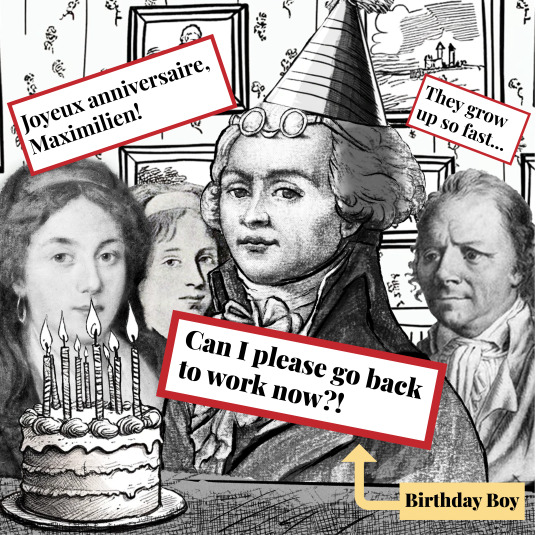
Two hundred and thirty years ago, on a Tuesday, Maximilien Robespierre turned 36.
There wasn’t much to celebrate.
It was an exceptionally bleak year. Famine persisted. France remained embroiled in war. A month earlier, one of his oldest friends had met a grim fate under the guillotine.
Robespierre had withdrawn from public life since April 19th. Rumours circulated about his health. Some speculated illness while others noted that he continued to endorse decrees from the Committee of Public Safety, so clearly, he wasn’t that unwell. Barère, (approach his accounts with with caution) visited him and implied he appeared dreadful, teetering on the brink of a breakdown.
Deep down, did he sense that it would be his final birthday? Maybe.
Did he mark the occasion in any way? Given that he delivered a formidable speech on the 7th of May concerning the intersection of religious and moral ideas with Republican principles, it’s unlikely there was any celebration. He probably wrote and wrote and wrote some more.
That being said, I like to imagine that the Duplays’ coaxed him from his study for a brief respite, gave him something yummy to eat, maybe raised a toast in his honour and reminded him of how cherished and precious he was to them.
Happy 266 birthday, Maximilien!
You are still cherished.
197 notes
·
View notes
Text
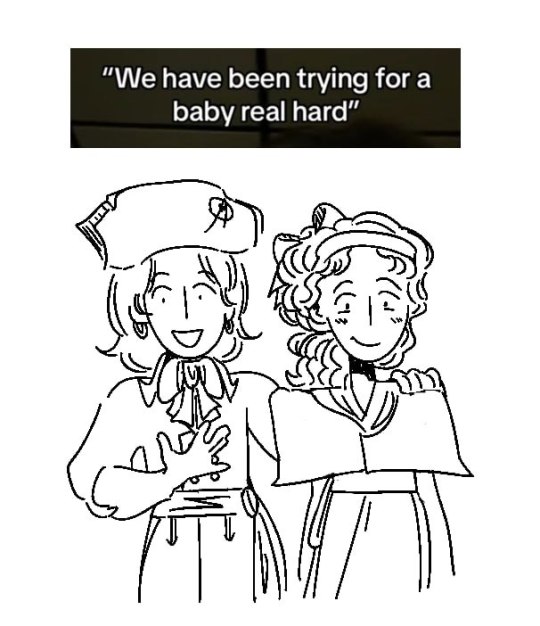
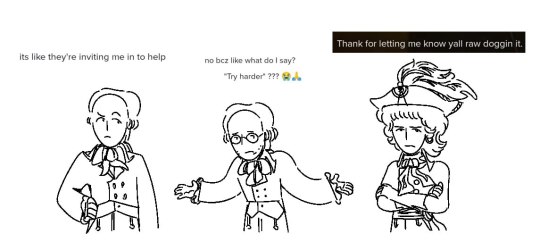
saw a tiktok thus the idea was born
#french revolution#frev#philippe le bas#elisabeth duplay#elisabeth le bas#augustin robespierre#bonbon robespierre#maximilien robespierre#louis antoine saint just#my art
279 notes
·
View notes
Text
Hi everyone eleonore and robespierre is currently taking over my mind

79 notes
·
View notes
Text
Thank you, Elisabeth Le Bas!

Thank you for these touching memoirs. Her modesty also moved me, as she is clearly one of those women behind the scenes who encouraged their revolutionary husbands, who would not have been as effective without them. She possesses an extraordinary strength of character and integrity that many men should have been inspired by instead of placing their individual interests first. The revolution could have been saved (no need to specify who I am targeting here). Although her memoirs may at first seem to portray a woman who simply supports those she loves, it is actually much deeper than that. She attended political debates with Charlotte Robespierre, showing that they were far more politically engaged than they appeared. By the way, I have a theory about Philippe Le Bas based on an excerpt from Elisabeth Le Bas:
"It was the day when Marat was borne in triumph to the Assembly that I saw my beloved Philippe Le Bas for the first time.
I found myself, that day, at the National Convention with Charlotte Robespierre. Le Bas came to greet her; he stayed with us for a long time and asked who I was. Charlotte told him that I was one of her elder brother’s host’s daughters. He asked her a few questions about my family; he asked Charlotte if we came to the Assembly often, and said that on a particular day there would be a rather interesting session. He urged her to come to it."
I haven’t found any evidence that Le Bas defended the rights of womens citizens (I hope I’m wrong because I really like him as a revolutionary, so feel free to correct me). Yet, I have no valid reason to doubt what he said to Charlotte Robespierre about encouraging these two women to attend a session of the Assembly. I get the impression that Le Bas was one of those men who valued women’s political opinions, had no problem with them attending political sessions, but didn’t see the point of them participating more actively in political life. I imagine he had no objections to discussing it privately with Elisabeth.
Philippe and Elisabeth Le Bas form such a touching couple (I almost applauded when they were finally able to marry), and I really liked that, together with Henriette Le Bas (another woman who is too unknown in the revolution, but fortunately Tumblr is here to bring them out of the shadows), she accompanied her husband and Saint-Just (she was one of the many women who accompanied the revolutionaries on their missions, like Charlotte Robespierre, Sophie Momoro, etc.).
I also really appreciated the relationship she had with Eleonore Duplay, where we also see the courage of her sister in adversity. Paradoxically, it’s in Elisabeth Le Bas’s memoirs that I began to appreciate Charlotte Robespierre. Charlotte Robespierre’s memoirs contain quite a few inaccuracies, as other Tumblr users have pointed out, and I thought to myself, it’s impossible, she’s way too “saintly,” I don’t believe it for a second (not to mention that she comes across as too apolitical, but I imagine those who helped write the memoirs didn’t want a thinking woman). Here, thanks to certain passages from Elisabeth and what we know from the Mathons, we have proof that she is certainly not a saint (no one is), but she’s not a heartless, toxic, or selfish woman as I’ve seen (not on Tumblr but on other forums, where they oddly bash Robespierre but blame Charlotte for disowning her brother; those who say these things are inconsistent, plus I’d like to see how they would have reacted if they had faced the same threat as Charlotte). She is a woman with touching qualities (like her kindness towards Elisabeth, her desire to accompany her brother on a mission, when she designated Mademoiselle Mathon as her heir, or that at the end of her life, she wanted to rehabilitate her brothers) but also with weaknesses (I would start with her completely inaccurate memoirs, I think the disagreement between Madame Duplay, Eleonore, and Charlotte involved shared faults, just like the dispute between Augustin and Charlotte, especially the letter Augustin wrote to Maximilien about Charlotte, etc.). Thanks to Elisabeth Le Bas’s memoirs, Charlotte Robespierre is neither a monster nor a too-perfect being, she is just a human being. By the way, I don’t blame her for disowning her family name and her brothers temporarily because the danger could have been real. She was a civilian who didn’t seek trouble, and in that respect, it was trouble (more precisely, the Thermidorians) that came to her. I also don’t blame her for asking Bonaparte for a pension and continuing to receive one under Louis XVIII because life for a single woman was very hard at that time. It took extraordinary strength of character to avoid doing all that, and not many people had it. Where I do criticize Charlotte Robespierre is for embellishing the reality concerning her in her memoirs.But it was very sad that she was not able to reconcile with her brothers especially Augustin before she died because none of them seem toxic to me. If France and the revolution had no longer been in danger, if they had survived, I think they would have reconciled, but I can't speak for them.
Returning to Elisabeth’s memoirs, I smiled when she idealized the revolutionaries she was close to, like the Robespierre brothers or Saint-Just, although after recognizing many of his qualities, she said he could sometimes be severe due to his great love for the country and the revolution. But it’s normal that she idealized them and defended them loyally because she was simply being loyal to the revolutionary struggles they were leading and in which she believed, even though it would have been good to see their flaws in her memoirs. Memoirs are always subjective, even from an honest person like Elisabeth Le Bas. Despite everything, she is attached to her country and is capable of making a judgment when she says in the excerpt, “Nevertheless, he needed to leave; Robespierre, who had great confidence in Le Bas because he knew his wise and prudent character well, had chosen him to accompany Saint-Just, whose burning love of the patrie sometimes led to too much severity, and who had a tendency to get carried away.” On the other hand, what troubles me about this statement is that normally, a person is not sent on a mission based on the will of just one other person; it usually requires the majority of votes within the CPS or the CSG (sometimes in the Convention). But we see that Elisabeth stays in the background yet makes a thoughtful political judgment to better safeguard the endangered French Revolution.
However, I didn’t like that Elisabeth constantly put herself down by describing herself as scatterbrained when everything indicated that she was not. I was saddened by the tragic fate of Philippe Le Bas, even though we all knew it was inevitable. At least they were able to say goodbye. At least he died before seeing the tragic outcome of the revolution. I found Madame Duplay’s death unfair. Poor Duplay family, who went through one tragedy after another but found the strength to bounce back. I admired Eleonore for helping Elisabeth during her most tragic moments in prison. I applauded when Elisabeth Le Bas showed astonishing courage in front of her adversaries from prison to her release. She never asked for anything and displayed extraordinary strength.
Even though I wouldn’t have blamed her for abandoning the revolution to survive with her son in such difficult times, she didn’t do it, whereas some “revolutionaries” greedy for their wallets destroyed the revolution, endangered France, and undermined the revolutionary people's efforts for social progress that had begun since 1789. The obligation of loyalty to the revolution that deputies like Fouché, Barras, or a general named Bonaparte should have respected was found in the daughter and wife of an authentic revolutionary (especially in the worst moments). Honor to her (and to the many men and women like Elisabeth) and shame on all those greedy ones (I must admit that my language is blunt and could be more nuanced if making a historical judgment, but I’m more in the realm of value judgment, so I feel I can allow myself some liberties, sorry for the fans of theses characters it's only my view).
On a more positive note, thank you, Elisabeth Le Bas, for fighting against this all-too-common black legend of the revolution through your memoirs.
Thank you for your journey as a fighter. If only the greedy deputies I mentioned earlier had a quarter of your integrity and courage and remembered that they were there to serve the people, as they are in their positions solely because of the people and thanks to them, the revolution would surely have lasted longer.
Thank you, Elisabeth, for all you did with so many others. May your life serve as an example and a source of strength for us.
70 notes
·
View notes
Text
Camille Desmoulins and Maximilien Robespierre – doomed by the Revolution?
a second part of the answer to the ask kindly sent by @iron--and--blood - first part can be found here
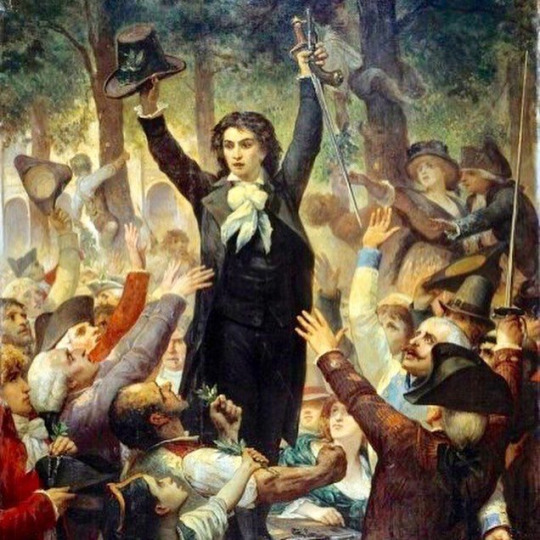

Okay, so I tried to follow the sources and I ended up missing what is arguably the key question. I think that there is enough evidence that warrants seeing Camille and Maximilien’s relationship as a ‘friendship torn apart but the revolution’, but could it in fact be something more that the chain of events of the mid-1790s ended up destroying?
(aka the good old “were they gay?” question)
It’s probably not surprising to anyone that there is no conclusive evidence that would suggest that either of them was definitely queer or that they were involved in some kind of a relationship. For context, the French Constitutional Assembly did decriminalise homosexuality, since there was simply no mention of private same-sex relationships it in the penal code of 1791.
Of course, there would still be a stigma surrounding queerness, seeing how France was a Catholic country – well, up to that point. On the other hand, it is also important to remember that anyone who received a higher education at that time would be well versed in classical authors (Greek and Roman that is), so they would have a framework for a positively viewed queer attraction/relationship (I'm mostly thinking of a kind of Alcibiades/Socrates vibes here. I think it sort of fits? Well it does in my headcanon anyway...). Camille especially seemed to be really into classics, making references to classical authors, history or mythology in approximately every other sentence.
CAMILLE – VICES HONTEUX AND A POSSIBILE BICON
If we consider Camille, I think it is clear that he was attracted to women. I think that the historical sources show that he genuinely did love his wife - Lucile - although it may also be true he was bit of a cad. There is a whole deal with him and Lucile’s mother with whom he apparently exchanged some flirty letters? I honestly need to look into it more at some point.
That said, attraction to women of course doesn’t exclude attraction to men. The one thing that would suggest Camille might have pursued a same-sex relationships is the reference to “vices honteux“ (shameful vices), which Saint-Just claims were attributed to Camille by Danton. We also learn from Robespierre’s note that this refered to something that was ‘totally unrelated to the revolution’.
So we know it’s something that would be seen as ‘shameful’ behaviour, but nonetheless a private matter. Could it be interest in same-sex relationships? It’s of course hard to say, but the theory is not completely implausible. For a discussion about this, I recommend this article.
MAXIMILIEN – A CONFIRMED BACHELOR?
With Maximilien Robespierre, it gets a little more complicated. He was essentially a confirmed bachelor, living with a family that adored him but that was not his own (and also a dog. He had a dog.) Talk about a found family trope!
Some sources claim that he was engaged to Éléonore Duplay, but Robespierre’s sister for one vehemently denies this. It’s true that he could probably easily have married her – I can’t imagine her family being opposed to it, far from it probably – but the fact is that for one reason or another, he did not.
He also didn’t really seem to capitalise on his massive popularity among the Parisian women. (Though, to be fair, neither did Rousseau and he was… well I guess he was his own version of heterosexual.)
Sure, one can interpret that as Robespierre being a workaholic or putting the revolution above everything else, but I personally think it is very possible that he would be considered to be on the asexual spectrum by today’s standards.
That said, although France was moving away from institutionalised religion at that point, Catholic guilt could certainly play a role, especially in someone who prided himself in his moral conduct and was told to be rigid about the rules. So the possibility of him being closeted as an explanation for his lack of interest in women would also not be completely off the table.
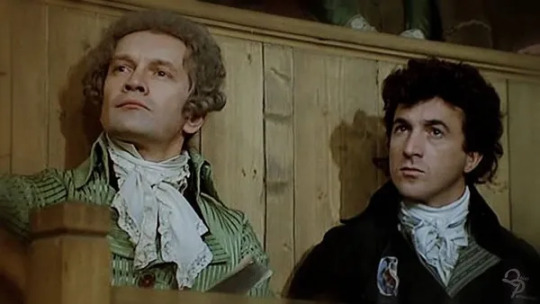
As to Camille and Maximilien being together in some way? I think there is certainly a precedence for this type of relationship in adolescence. Seeing that they have studied together (and shared enthusiasm for classics probably), it is not impossible, though of course, it is highly speculative.
I think it is also fair to say that Robespierre went above and beyond for Camille until the last few months. That is something he probably would have not done for many other people. He actually said as much himself:
“Learn, Camille, that if you were not Camille, one could not have so much indulgence for you.“
Was it because Camille was universally liked by the revolutionaries for all the good he has done? Possibly, but I think one can also read more into it. It certainly suggests that Camille was special in some way, and the fact that Robespierre uses ‚one‘ instead of ‚I‘ does not necessarily mean he is not speaking about himself here.
CAMILLE AND MAXIMILIEN IN THE MEDIA
When it comes to media portrayal, the relationship often comes across as queer-coded - to an extent.



In La Révolution française, this aspect is more prominent between Robespierre and Saint-Just, but with some well-timed smiles and glances, it almost reads as a tragic love triangle between the three. There are some unfortunate implications however, mainly that the hints of Robespierre's queerness in the movie are implicitly associated with his descent to tyrany. Ugh. (And let's face it, a kind of effeminacy linked to villainy as well. Honestly, who thought that kind of portrayal would be a good idea? Kudos for making a historical movie about the French Revolution come across as homophobic I guess.)
Hilary Mantel straight-up makes Camille Desmoulins bisexual (ish?) in A Place of Greater Safety, though there are <a lot of> issues with that portrayal, as discussed here (watch me linking another mutual's great post! Frevblr is truly the best). Not sure how the relationship with Robespierre is presented here since it’s one of the books I’ve been in the middle of for months.
And then there’s Stanisława Przybyszewska of course. She would honestly warrant a separate post, but long story short: in her works, there is no doubt about the fact that she portrays the relationship between them as queer. She invokes the Erastes/eromenos dynamic between them (quite explicitly, referring to Camille as an ephebe at one point) and makes the attraction between the two seem palpable. There is plenty of queer (under)tones to be found in The Danton Case, but in Last Nights of Ventôse , she straight up interprets the fall of the Dantonists as Camille running into Danton’s arms to spite Robespierre for snubbing him and rejecting his devotion (romantic advances?). And it gets quite physical – not in a way that would warrant an E rating, but it would certainly deserve one for the sheer emotional intensity.
#there is a great fic that explores the idea of Robespierre being ace btw. Features some A+ philosophical discussions as well#the only issue is the fact that the other person in the pairing is --#no - shan't say!#frev#french revolution#asks#camille desmoulins#maximilien robespierre#queer history#frevblr#frev community#robesmoulins#1700s#history#stanisława przybyszewska#hilary mantel#a place of greater safety#the danton case#la révolution française#la revolution francaise#bisexuality#asexuality#Éléonore Duplay#robespierre#desmoulins#queer analysis#saint-just#louis antoine de saint just#lucile desmoulins#georges danton
78 notes
·
View notes
Text
Things Jacques Ravenne, author of La Chute, a French Revolution novel set on the 8, 9 and 10 Thermidor published in 2020, should be guillotined for:
1. Robespierre saying his sister Charlotte was "never beautiful nor intelligent" in a conversation with Bonbon about Charlotte and Fouché

2. Eleonore Duplay being in love with Robespierre and going to the Convention to see him give speeches but being described as "not caring about politics" (she just likes seeing Robespierre be applauded):

"Is he a friend of Maximilien ?" asked Eleonore, who had no interest in politics"
#jacques ravenne: la chute#they both deserve better#and I can't imagine Robespierre being this gratuitously mean about Charlotte#charlotte robespierre#eleonore duplay
40 notes
·
View notes
Text



Robespierre siblings having breakfast at Duplays. + Brount.
+ an alternative morning
That second picture will haunt me in my dreams istg
#myart#maximilien robespierre#charlotte robespierre#augustin robespierre#bonbon#eleonore duplay#frev community#frev art#frev
252 notes
·
View notes
Text
Leolotte 💛

48 notes
·
View notes
Photo
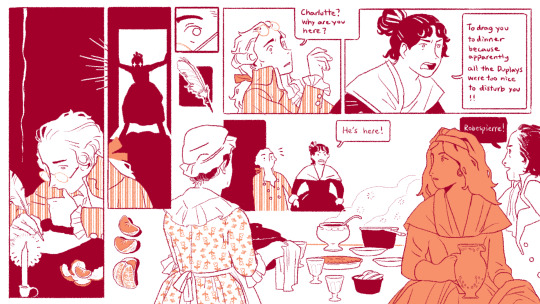


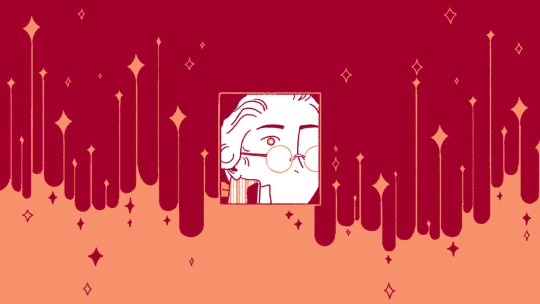


A small comic about how Robespierre is useless in the kitchen (and also enjoying a holiday dinner).
Tried to make the dish choices a little more modest and something the Duplays could possibly afford, though I could be completely off (Reference: Tasting History with Max Miller, Le Cuisinier Gascon (1740), La Cuisinière Bourgeoise (1746) )
Happy Holiday!
#robespierre#duplay#charlotte robespierre#augustin robespierre#bonbon#comic#personal art#personal work#french revolution#christmas
763 notes
·
View notes
Note
Which revolutionaries had earrings?
All I really know of are Éléonore Duplay, Lucile Desmoulins and Philippe Le Bas, who all wear hoop earrings in the most famous (and, in Éléonore and Philippe’ case, only) portraits presumed to be depicting them. Since these are just portraits, it’s however hard to say if they wore earrings everyday or just put them on for this specific occasion.
The common claim that Saint-Just had earrings does interestingly enough not appear to be that well backed up. There is only a single depiction where ”he” has one, and it’s not one of the four that we can be almost certain is Saint-Just. You can read more about it here: 1, 2, 3, 4.
#saint just#louis antoine saint just#éléonore duplay#lucile desmoulins#philippe le bas#frev#french revolution#ask#love crushing these frev myths…
59 notes
·
View notes
Text
More Père Lachaise with @robespapier
Eleonore:

Babet and Junior:
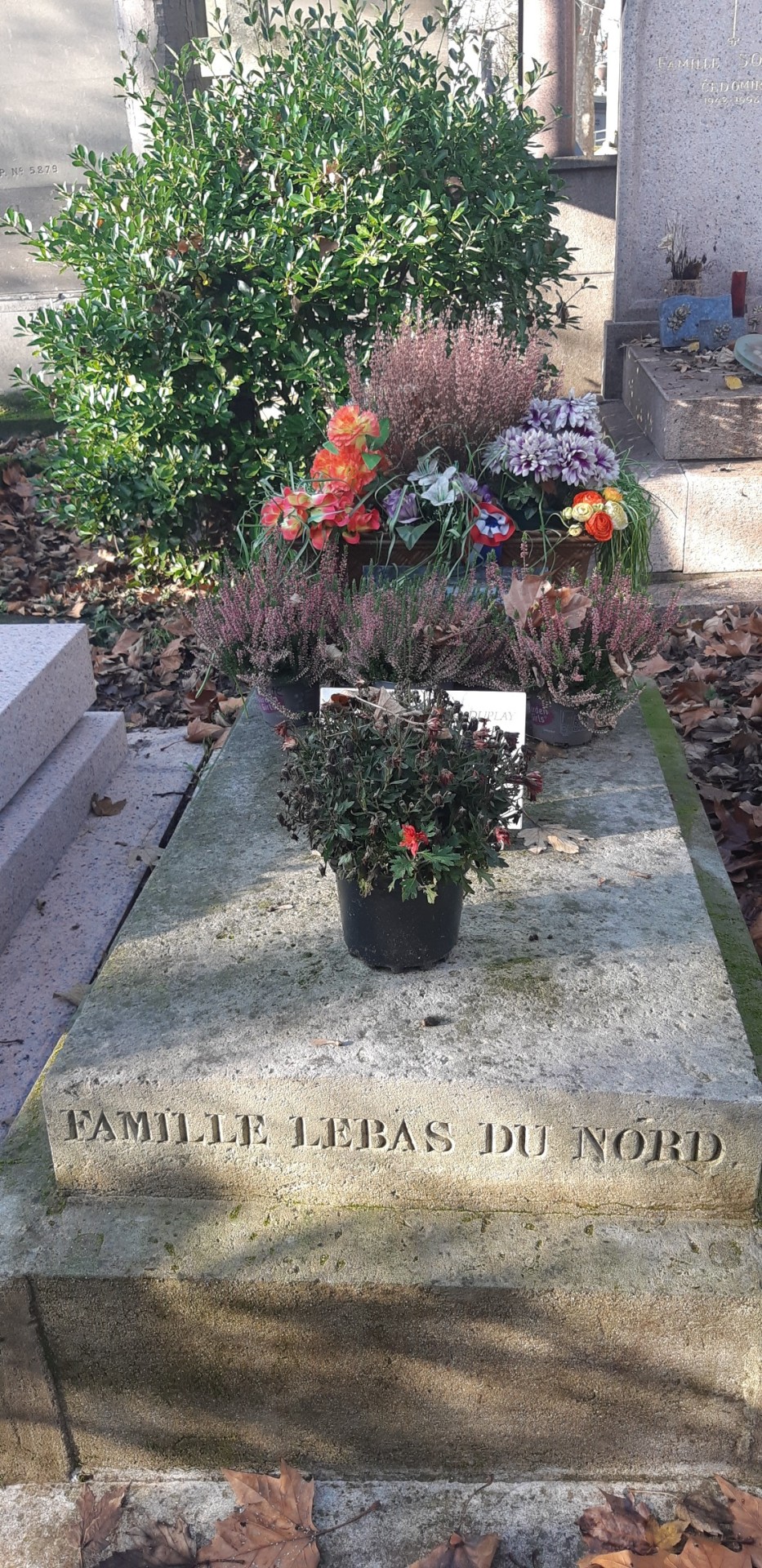


Barras (look at the sad state of it):
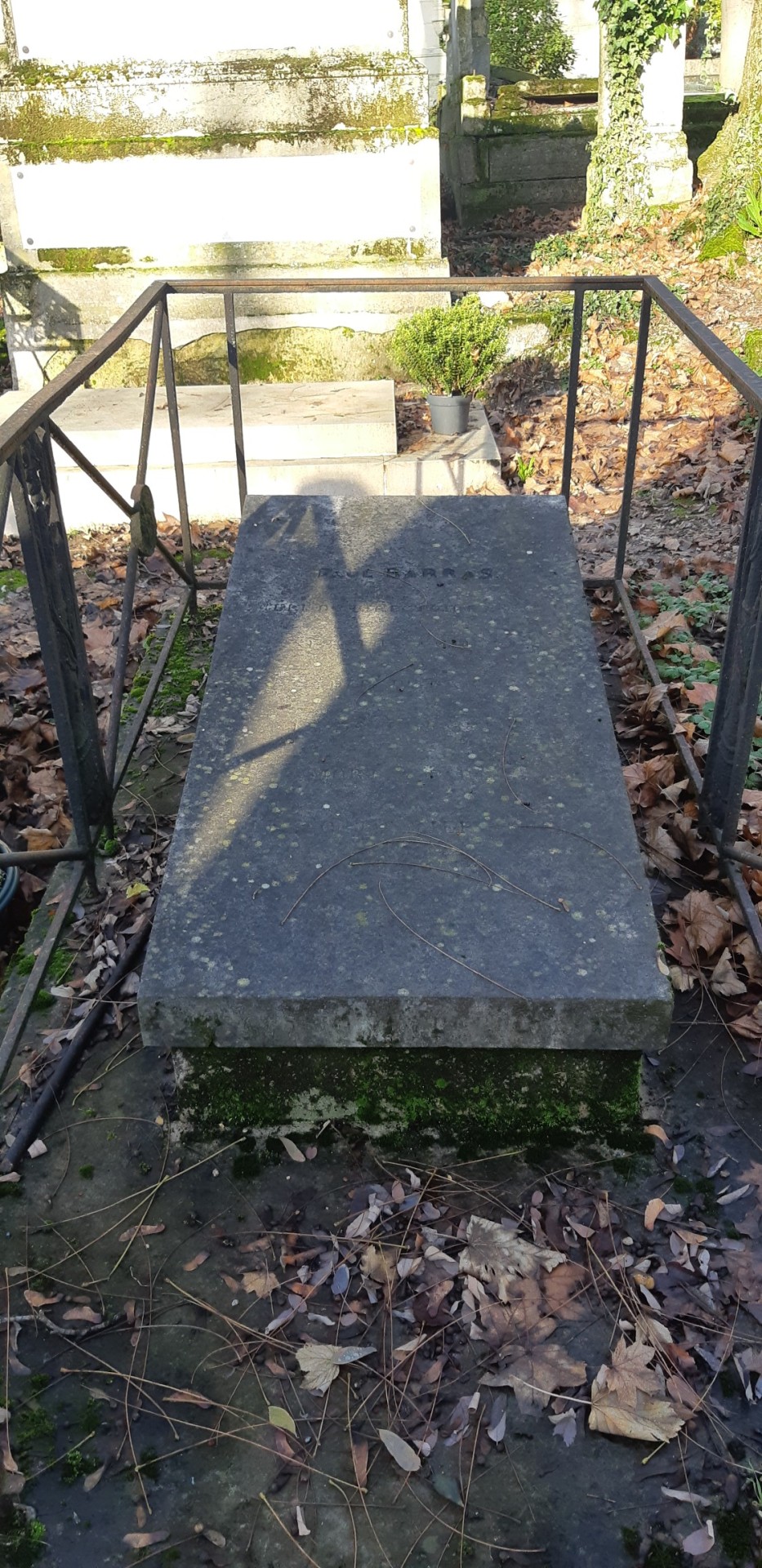

Tallien again:

And last, but certainly not the least, Fouché's daughter in law (captured because of the last name alone tbh.)

His son is also buried at Père Lachaise but we didn't have time to visit him. Apparently, he does NOT have "Fouché" on the tombstone! Just "F." and "d'Otrante". (Come on, be proud of the snake name!)
62 notes
·
View notes
Text
3 different pictures of Eleonore mourning Maxim
inspired by the song "Плак-плак" by IС3PEAK
(Pls listen to it if you haven't already)



21 notes
·
View notes
Text

#my art#maximillian robespierre#louis antoine saint just#augustin robespierre#charlotte robespierre#eleonore duplay#robespierre#saint just#bon bon#charlotte#frev#frevblr#french revolution
245 notes
·
View notes
Text

Six fanarts challenge!
It was quite fun to do, might do more in the future!
#art#my art#french revolution#frev#antoine saint just#maximilien robespierre#camille desmoulins#jean lannes#adelaide labille-guiard#eleonore duplay#napoleonic era#empire era#six fanarts
158 notes
·
View notes
Text
Sometimes, a family can be a pro-revolutionary cabinetmaker, his wife, their four daughters and a son, and the brilliant-yet-slightly-awkward middle-aged politician they decided to adopt
#and his dog of course!#has this been done before?#frev#frev memes#french revolution#maximilien robespierre#the duplays#éléonore duplay#élisabeth duplay#history memes#history shitposting#frev community#hall of fame
44 notes
·
View notes